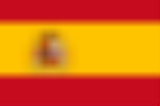
List of Spanish flags
Encyclopedia
List of Spanish flags
This is a list of flags used in Spain
. For more information about the national flag, visit the article Flag of Spain
.
This is a list of flags used in Spain
Spain
Spain , officially the Kingdom of Spain languages]] under the European Charter for Regional or Minority Languages. In each of these, Spain's official name is as follows:;;;;;;), is a country and member state of the European Union located in southwestern Europe on the Iberian Peninsula...
. For more information about the national flag, visit the article Flag of Spain
Flag of Spain
The flag of Spain , as it is defined in the Spanish Constitution of 1978, consists of three horizontal stripes: red, yellow and red, the yellow stripe being twice the size of each red stripe...
.
National Flags
| Flag | |Use | National Flag with coat of arms National flag A national flag is a flag that symbolizes a country. The flag is flown by the government, but usually can also be flown by citizens of the country.Both public and private buildings such as schools and courthouses may fly the national flag... , National flag National flag A national flag is a flag that symbolizes a country. The flag is flown by the government, but usually can also be flown by citizens of the country.Both public and private buildings such as schools and courthouses may fly the national flag... , State flag State flag There are two separate meanings for the term state flag in vexillology – the flag of the government of a sovereign state, and the flag of an individual subnational state.-Government flag:... , State ensign, Civil ensign Civil ensign The civil ensign is the national flag flown by civil ships to denote nationality... and War ensign | National flag with coat of arms |
|---|---|---|---|
.svg.png) |
1843-1931 1939- |
Civil ensign Civil ensign The civil ensign is the national flag flown by civil ships to denote nationality... for civil use |
The flag of Spain consists of three horizontal stripes: red, yellow and red, the yellow strip being twice as wide as each red stripe. |
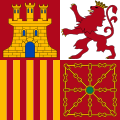 |
1945- | Naval Jack | A squared flag divided into four squares representing the four Kingdoms of Spain with navies in the Middle Ages: Castile (represented by a castle, top left), Leon (represented by a heraldic lion, top right), Aragon (represented by four pallets, bottom left), and Navarre (represented by an orle of chains, bottom right) |
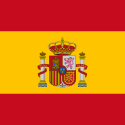 |
1982- | High Civil Authorities' Flag | A square flag of Spain with the Spanish coat of arms on the centre |
 |
1977- | Yachts Ensign. | The flag of Spain with a blue plain Royal Crown in the center |
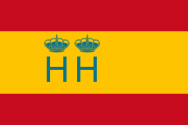 |
1977- | Customs Service Ensign | The flag of Spain with two crowned "H" |
Royal Standard
| Flag | |Use | Standard of the King of Spain Royal Standard of Spain The Royal Standard of Spain is the official flag of the King of Spain. The present design is regulated by Title II, Rule 2, of Spanish Royal Decree 1511 of 21 January, 1977, whereby the Rules for Flags, Standards, Guidons, Banners and Badges are adopted.The Royal Standard of Spain consists of a... | A dark blue square with the Coat of arms of the King Coat of arms of the King of Spain The blazoning of the coat of arms of the King of Spain is set out in Title II, Rule 1, of Spanish Royal Decree 1511 of 21 January 1977, by which the Rules for Flags, Standards, Guidons, Banners, and Badges were adopted.- Quartered shield :... in the center. |
|---|---|---|---|
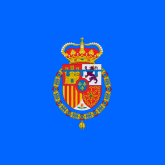 |
2001- | Standard Royal Standard of Spain The Royal Standard of Spain is the official flag of the King of Spain. The present design is regulated by Title II, Rule 2, of Spanish Royal Decree 1511 of 21 January, 1977, whereby the Rules for Flags, Standards, Guidons, Banners and Badges are adopted.The Royal Standard of Spain consists of a... of the Prince of Asturias Prince of Asturias Prince of Asturias is the historical title given to the heir to the Spanish throne. It was also the title under the earlier Kingdom of Castile. The current Prince of Asturias is Felipe, son of King Juan Carlos of Spain and Queen Sofía... |
A light blue square with the Coat of arms of the Prince Coat of arms of the Prince of Asturias The blazon of the coat of arms of the Prince of Asturias appears in Royal Decree 284 of 16 March 2001, whereby His Guidon and His Standard are created.QUARTERED SHIELD:... in the center. |
Autonomous Communities
See: Flags of the Autonomous CommunitiesFlags of the autonomous communities of Spain
This gallery of flags of the autonomous communities of Spain shows the distinctive flags of the 17 autonomous communities of Spain ....
| Flag | |Use | Andalusia Andalusia Andalusia is the most populous and the second largest in area of the autonomous communities of Spain. The Andalusian autonomous community is officially recognised as a nationality of Spain. The territory is divided into eight provinces: Huelva, Seville, Cádiz, Córdoba, Málaga, Jaén, Granada and... > | three equal horizontal bands of green (top), white and green, there is an Andalucian coat of arms in center the white band. |
|---|---|---|---|
 |
Flag of Aragon Aragon Aragon is a modern autonomous community in Spain, coextensive with the medieval Kingdom of Aragon. Located in northeastern Spain, the Aragonese autonomous community comprises three provinces : Huesca, Zaragoza, and Teruel. Its capital is Zaragoza... |
nine equal horizontal stripes of yellow (top, double width) and red, there is an Aragon coat of arms in left the red and yellow bands, the coat of arms feautered a gold crown have four green small diamonds and three red small disk, the shield means four corner, first corner means (yellow field with a red cross in upper tree), second corner means (violet field with white cross in hoist-side left corner, third corner means (red St. George and St. Andrew cross have four corners have four man heads) and fourth corner means (nine equal vertical bands of yellow (top, double width) and red). | |
 |
Flag of Flag of Asturias 250px|thumb|right|Flag of AsturiasThe flag of Asturias shows the "Cruz de la Victoria" in gold over blue .... the Principality of Asturias Asturias The Principality of Asturias is an autonomous community of the Kingdom of Spain, coextensive with the former Kingdom of Asturias in the Middle Ages... |
blue field with the Victory Cross Victory Cross The Victory Cross is an early 10th century Asturian Christian ornamented processional cross, which was, as an inscription says, made in 908 in the Castle of Gauzón . It is a crux gemmata or jewelled cross, given by King Alfonso III of Asturias, who reigned from 848 to 910, to Cathedral of San... in center, hanging from the horizontal axis on either side of the cross are an upper-case Greek letter Alpha (Α) on the left and a lower-case Omega (ω) on the right. |
|
 |
Flag of the Balearic Islands Balearic Islands The Balearic Islands are an archipelago of Spain in the western Mediterranean Sea, near the eastern coast of the Iberian Peninsula.The four largest islands are: Majorca, Minorca, Ibiza and Formentera. The archipelago forms an autonomous community and a province of Spain with Palma as the capital... |
nine equal horizontal stripes of yellow (top, double width), and red, there is a Balearic castle in purple hoist-side upper left corner. | |
 |
The Ikurriña, the Flag of the Basque Autonomous Community Basque Country (autonomous community) The Basque Country is an autonomous community of northern Spain. It includes the Basque provinces of Álava, Biscay and Gipuzkoa, also called Historical Territories.... |
red field with the white cross of Saint George edged in white superimposed on the diagonal green cross of Saint Patrick, which is superimposed on the diagonal green cross of Saint Andrew. | |
 |
Flag of Flag of the Canary Islands The flag of the Autonomous Community of the Canary Islands is a vertical tricolour of three equal bands of white, blue, and yellow. The state flag includes the Coat of arms of the Canary Islands in the central band; the civil flag omits this... the Canary Islands Canary Islands The Canary Islands , also known as the Canaries , is a Spanish archipelago located just off the northwest coast of mainland Africa, 100 km west of the border between Morocco and the Western Sahara. The Canaries are a Spanish autonomous community and an outermost region of the European Union... |
three equal vertical bands of white (top), blue, and yellow, there is a Canary Island coat of arms in center the blue band, the coat of arms feautered the word motto "OCEANO" in silver ribbon in upper, royal crown in middle and two dogs are holding the shield in lower, the shield have seven hillocks. | |
 |
Flag of Flag of Cantabria The colors of the official flag of Cantabria , which is the symbol of the region, are established in the very text of the Autonomy Statute. Only the characteristics of the coat of arms that was to feature in the regional flag were left to specify, which was carried out by a Law of the Regional... Cantabria Cantabria Cantabria is a Spanish historical region and autonomous community with Santander as its capital city. It is bordered on the east by the Basque Autonomous Community , on the south by Castile and León , on the west by the Principality of Asturias, and on the north by the Cantabrian Sea.Cantabria... |
two equal horizontal bands of white (top), and red, there is a Cantabria coat of arms in center the white and red bands, the coat or arms feautered a royal crown in upper with shield, the shield feautered two girls head are seeing in blue sky background with a ship are going with water bearing a sea castle in after ship. | |
 |
Flag of Castile-La Mancha Castile-La Mancha Castile-La Mancha is an autonomous community of Spain. Castile-La Mancha is bordered by Castile and León, Madrid, Aragon, Valencia, Murcia, Andalusia, and Extremadura. It is one of the most sparsely populated of Spain's autonomous communities... |
||
 |
Flag of Castile and León Castile and León Castile and León is an autonomous community in north-western Spain. It was so constituted in 1983 and it comprises the historical regions of León and Old Castile... |
Two Lions from the Kingdom of León Kingdom of León The Kingdom of León was an independent kingdom situated in the northwest region of the Iberian Peninsula. It was founded in AD 910 when the Christian princes of Asturias along the northern coast of the peninsula shifted their capital from Oviedo to the city of León... and two towers from Castile. |
|
 |
La Senyera Senyera The Senyera is a vexillological symbol based on the coat of arms of the Crown of Aragon, which consists of four red stripes on a golden background... , the Flag of Catalonia Catalonia Catalonia is an autonomous community in northeastern Spain, with the official status of a "nationality" of Spain. Catalonia comprises four provinces: Barcelona, Girona, Lleida, and Tarragona. Its capital and largest city is Barcelona. Catalonia covers an area of 32,114 km² and has an... |
||
 |
Flag of Flag of Ceuta The flag of the Spanish Autonomous City of Ceuta is a black and white gyronny with a central escutcheon displaying the municipal coat of arms.... Ceuta Ceuta Ceuta is an autonomous city of Spain and an exclave located on the north coast of North Africa surrounded by Morocco. Separated from the Iberian peninsula by the Strait of Gibraltar, Ceuta lies on the border of the Mediterranean Sea and the Atlantic Ocean. Ceuta along with the other Spanish... |
||
 |
Flag of Extremadura Extremadura Extremadura is an autonomous community of western Spain whose capital city is Mérida. Its component provinces are Cáceres and Badajoz. It is bordered by Portugal to the west... |
||
 |
Flag of Flag of Galicia The flag of Galicia was created in the 19th century as a copy of the flag of the Galician maritime province of A Coruña.-Legend:During the 19th century many thousands of Galicians emigrated to the Americas; A Coruña was the main Galician port from which they departed... Galicia |
||
.svg.png) |
Flag of La Rioja La Rioja (Spain) La Rioja is an autonomous community and a province of northern Spain. Its capital is Logroño. Other cities and towns in the province include Calahorra, Arnedo, Alfaro, Haro, Santo Domingo de la Calzada, and Nájera.-History:... |
||
 |
Flag of Madrid | ||
 |
Flag of Flag of Melilla The flag of Melilla, a Spanish enclave in North Africa, consists of a pale blue background with the city's coat of arms in the centre.... Melilla Melilla Melilla is a autonomous city of Spain and an exclave on the north coast of Morocco. Melilla, along with the Spanish exclave Ceuta, is one of the two Spanish territories located in mainland Africa... |
||
 |
Flag of Murcia | ||
 |
Flag of Navarre Navarre Navarre , officially the Chartered Community of Navarre is an autonomous community in northern Spain, bordering the Basque Country, La Rioja, and Aragon in Spain and Aquitaine in France... |
||
.svg.png) |
the Senyera coronada, Flag of Valencia |
Flags
See also: Flag of SpainFlag of Spain
The flag of Spain , as it is defined in the Spanish Constitution of 1978, consists of three horizontal stripes: red, yellow and red, the yellow stripe being twice the size of each red stripe...
| Flag | |Use | Cross of Burgundy Flag Cross of Burgundy Flag The Cross of Burgundy flag was used by Spain 1506-1701 as a naval ensign, and up to 1843 as the land battle flag, and still appears on regimental colours, badges, shoulder patches and company guidons... , Military flag, also used as flag of the Spanish Overseas Territories | A red saltire Saltire A saltire, or Saint Andrew's Cross, is a heraldic symbol in the form of a diagonal cross or letter ex . Saint Andrew is said to have been martyred on such a cross.... resembling two crossed, roughly-pruned (knotted) branches, on a white field. |
|---|---|---|---|
| 1701–1771 | Flag used in naval bases and coast defenses | ||
| 1701–1785 | Naval ensign | ||
| 1701–1748 | Etiquette's Naval ensign | ||
| 1748–1785 | Etiquette's Naval ensign | ||
 |
1785–1927 | Merchant marine's flag | |
.svg.png) |
1785-1873 / 1874-1931 | War ensign (1785–1843). National Flag (1843–1873 and 1874–1931) | |
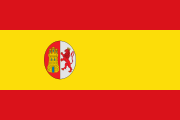 |
1873–1874 | Flag of the First Spanish Republic | |
 |
1931–1939 | Flag of the Second Spanish Republic | |
| 1936–1938 | Flag of Spain (Spain under Franco's Rule) | ||
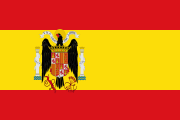 |
1938–1945 | Flag of Spain (Spain under Franco's Rule) | |
 |
1945–1977 | Flag of Spain (Spain under Franco's Rule) | |
 |
1977–1981 | National Flag |
Royal Banners of arms
| Flag | |Use | Catholic Monarchs Catholic Monarchs The Catholic Monarchs is the collective title used in history for Queen Isabella I of Castile and King Ferdinand II of Aragon. They were both from the House of Trastámara and were second cousins, being both descended from John I of Castile; they were given a papal dispensation to deal with... | |
|---|---|---|---|
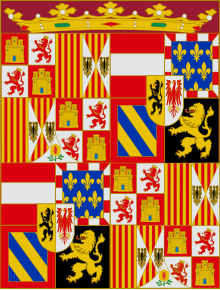 |
1518–1556 | Banner of arms of King Charles I Charles V, Holy Roman Emperor Charles V was ruler of the Holy Roman Empire from 1519 and, as Charles I, of the Spanish Empire from 1516 until his voluntary retirement and abdication in favor of his younger brother Ferdinand I and his son Philip II in 1556.As... |
|
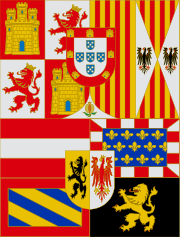 |
1580–1668 | Banner of arms of the House of Austria (with the arms of Portugal Coat of arms of Portugal The coat of arms of Portugal was officially adopted on 30 June 1911, along with the republican flag of Portugal. It is based on the coat of arms used by the Portuguese Kingdom since the Middle Ages.-History and meaning:... ) |
|
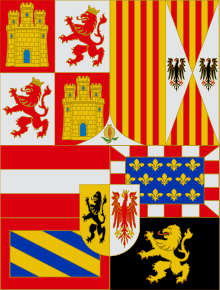 |
1668–1700 | Banner of arms of the House of Austria (from 1668) |
|
| 1700–1761 | Banner of arms of the House of Bourbon House of Bourbon The House of Bourbon is a European royal house, a branch of the Capetian dynasty . Bourbon kings first ruled Navarre and France in the 16th century. By the 18th century, members of the Bourbon dynasty also held thrones in Spain, Naples, Sicily, and Parma... |
||
.svg.png) |
1761 - 1868 1875 - 1931 |
Banner of arms of the House of Bourbon | |
| 1931 | Banner of arms of King Alfonso XIII |
Royal standards (Common use)
| Flag | |Use | ||
|---|---|---|---|
| Flag | |Use | Manuel Azaña Manuel Azaña Manuel Azaña Díaz was a Spanish politician. He was the first Prime Minister of the Second Spanish Republic , and later served again as Prime Minister , and then as the second and last President of the Republic . The Spanish Civil War broke out while he was President... | |
| 1940–1975 | Standard of Francisco Franco Francisco Franco Francisco Franco y Bahamonde was a Spanish general, dictator and head of state of Spain from October 1936 , and de facto regent of the nominally restored Kingdom of Spain from 1947 until his death in November, 1975... . |

